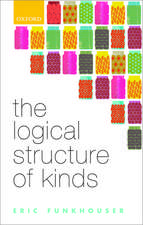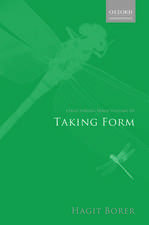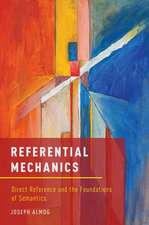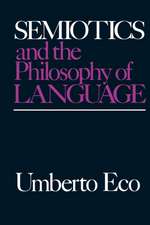Logic, Language, and Meaning, Volume 1: Introduction to Logic
Autor L. T. F. Gamuten Limba Engleză Paperback – 15 dec 1990
Although the two volumes of Logic, Language, and Meaning can be used independently of one another, together they provide a comprehensive overview of modern logic as it is used as a tool in the analysis of natural language. Both volumes provide exercises and their solutions.
Volume 1, Introduction to Logic, begins with a historical overview and then offers a thorough introduction to standard propositional and first-order predicate logic. It provides both a syntactic and a semantic approach to inference and validity, and discusses their relationship. Although language and meaning receive special attention, this introduction is also accessible to those with a more general interest in logic.
In addition, the volume contains a survey of such topics as definite descriptions, restricted quantification, second-order logic, and many-valued logic. The pragmatic approach to non-truthconditional and conventional implicatures are also discussed. Finally, the relation between logic and formal syntax is treated, and the notions of rewrite rule, automation, grammatical complexity, and language hierarchy are explained.
Volume 1, Introduction to Logic, begins with a historical overview and then offers a thorough introduction to standard propositional and first-order predicate logic. It provides both a syntactic and a semantic approach to inference and validity, and discusses their relationship. Although language and meaning receive special attention, this introduction is also accessible to those with a more general interest in logic.
In addition, the volume contains a survey of such topics as definite descriptions, restricted quantification, second-order logic, and many-valued logic. The pragmatic approach to non-truthconditional and conventional implicatures are also discussed. Finally, the relation between logic and formal syntax is treated, and the notions of rewrite rule, automation, grammatical complexity, and language hierarchy are explained.
Preț: 280.76 lei
Nou
Puncte Express: 421
Preț estimativ în valută:
53.73€ • 55.67$ • 44.84£
53.73€ • 55.67$ • 44.84£
Carte disponibilă
Livrare economică 28 februarie-14 martie
Livrare express 13-19 februarie pentru 30.58 lei
Preluare comenzi: 021 569.72.76
Specificații
ISBN-13: 9780226280851
ISBN-10: 0226280853
Pagini: 296
Ilustrații: 11figs.45tabs.
Dimensiuni: 152 x 229 x 30 mm
Greutate: 0.4 kg
Ediția:1
Editura: University of Chicago Press
Colecția University of Chicago Press
ISBN-10: 0226280853
Pagini: 296
Ilustrații: 11figs.45tabs.
Dimensiuni: 152 x 229 x 30 mm
Greutate: 0.4 kg
Ediția:1
Editura: University of Chicago Press
Colecția University of Chicago Press
Notă biografică
L. T. F. Gamut is a collective pseudonym for J. F. A. K. van Benthem, professor of mathematical logic; J. A. G. Groenendijk, associate professor of philosophy and computational linguistics; D. H. J. de Jongh, associate professor of mathematics and philosophy; M. J. B. Stokhof, associate professor of philosophy and computational linguistics, all at the University of Amsterdam, and H. J. Verkuyl, professor of linguistics at the University of Utrecht.
Cuprins
Foreword
Preface
1. Introduction
1.1. Arguments, Valid Arguments, and Argument Schemata
1.2. Logic and Meaning
1.3. Logical Constants and Logical Systems
1.4. Logic and Linguistics before the Twentieth Century
1.5. The Twentieth Century
1.5.1. Logical Form versus Grammatical Form
1.5.2. Ordinary Language Philosophy
1.5.3. Linguistics and Philosophy
1.6. Formal Languages
2. Propositional Logic
2.1. Truth-Functional Connectives
2.2. Connectives and Truth Tables
2.3. Formulas
2.4. Functions
2.5. The Semantics of Propositional Logic
2.6. Truth Functions
2.7. Coordinating and Subordinating Connectives
3. Predicate Logic
3.1. Atomic Setences
3.2. Quantifying Expressions: Quantifiers
3.3. Formulas
3.4. Some More Quantifying Expressions and Their Translations
3.5. Sets
3.6. The Semantics of Predicate Logic
3.6.1. Interpretation Functions
3.6.2. Interpretation by Substitution
3.6.3. Interpretation by Means of Assignments
3.6.4. Universal Validity
3.6.5. Rules
3.7. Identity
3.8. Some Properties of Relations
3.9. Function Symbols
4. Arguments and Inferences
4.1. Arguments and Argument Schemata
4.2. Semantic Inference Relations
4.2.1. Semantic Validity
4.2.2. The Principle of Extensionality
4.3. Natural Deduction: A Syntactic Approach to Inference
4.3.1. Introduction and Elimination Rules
4.3.2. Conjunction
4.3.3. Implication
4.3.4. Disjunction
4.3.5. Negation
4.3.6. Quantifiers
4.3.7. Rules
4.4. Soundness and Completeness
5. Beyond Standard Logic
5.1. Introduction
5.2. Definite Descriptions
5.3. Restricted Quantification: Many-Sorted Predicate Logic
5.4. Second-Order Logic
5.5. Many-Valued Logic
5.5.1. Introduction
5.5.2. Three-Valued Logical Systems
5.5.3. Three-Valued Logics and the Semantic Notion of Presupposition
5.5.4. Logical Systems with More than Three Values
5.5.5. Four-Valued Logics and the Semantic Notion of Presupposition
5.5.6. The Limits of Many-Valued Logics in the Analysis of Presupposition
5.6. Elimination of Variables
6. Pragmatics: Meaning and Usage
6.1. Non-Truth-Conditional Aspects of Meaning
6.2. Logical Conjunction and Word Order
6.3. Usage and the Cooperation Principle
6.4. Inclusive and Exclusive Disjunction
6.5. Disjunctions and Informativeness
6.6. Conversational Maxims and Conversational Implicatures
6.7. The Controversial Implicatures of Disjunctions
6.8. Implication and Informativeness
6.9. Presuppositions and Conversational Implicatures
6.10. Conventional Implicatures, Presuppositions, and Implications
7. Formal Syntax
7.1. The Hierarchy of Rewrite Rules
7.2. Grammars and Automata
7.3. The Theory of Formal Languages
7.4. Grammatical Complexity of Natural Languages
7.5. Grammars, Automata, and Logic
Solutions to Exercises
Bibliographical Notes
References
Index
Preface
1. Introduction
1.1. Arguments, Valid Arguments, and Argument Schemata
1.2. Logic and Meaning
1.3. Logical Constants and Logical Systems
1.4. Logic and Linguistics before the Twentieth Century
1.5. The Twentieth Century
1.5.1. Logical Form versus Grammatical Form
1.5.2. Ordinary Language Philosophy
1.5.3. Linguistics and Philosophy
1.6. Formal Languages
2. Propositional Logic
2.1. Truth-Functional Connectives
2.2. Connectives and Truth Tables
2.3. Formulas
2.4. Functions
2.5. The Semantics of Propositional Logic
2.6. Truth Functions
2.7. Coordinating and Subordinating Connectives
3. Predicate Logic
3.1. Atomic Setences
3.2. Quantifying Expressions: Quantifiers
3.3. Formulas
3.4. Some More Quantifying Expressions and Their Translations
3.5. Sets
3.6. The Semantics of Predicate Logic
3.6.1. Interpretation Functions
3.6.2. Interpretation by Substitution
3.6.3. Interpretation by Means of Assignments
3.6.4. Universal Validity
3.6.5. Rules
3.7. Identity
3.8. Some Properties of Relations
3.9. Function Symbols
4. Arguments and Inferences
4.1. Arguments and Argument Schemata
4.2. Semantic Inference Relations
4.2.1. Semantic Validity
4.2.2. The Principle of Extensionality
4.3. Natural Deduction: A Syntactic Approach to Inference
4.3.1. Introduction and Elimination Rules
4.3.2. Conjunction
4.3.3. Implication
4.3.4. Disjunction
4.3.5. Negation
4.3.6. Quantifiers
4.3.7. Rules
4.4. Soundness and Completeness
5. Beyond Standard Logic
5.1. Introduction
5.2. Definite Descriptions
5.3. Restricted Quantification: Many-Sorted Predicate Logic
5.4. Second-Order Logic
5.5. Many-Valued Logic
5.5.1. Introduction
5.5.2. Three-Valued Logical Systems
5.5.3. Three-Valued Logics and the Semantic Notion of Presupposition
5.5.4. Logical Systems with More than Three Values
5.5.5. Four-Valued Logics and the Semantic Notion of Presupposition
5.5.6. The Limits of Many-Valued Logics in the Analysis of Presupposition
5.6. Elimination of Variables
6. Pragmatics: Meaning and Usage
6.1. Non-Truth-Conditional Aspects of Meaning
6.2. Logical Conjunction and Word Order
6.3. Usage and the Cooperation Principle
6.4. Inclusive and Exclusive Disjunction
6.5. Disjunctions and Informativeness
6.6. Conversational Maxims and Conversational Implicatures
6.7. The Controversial Implicatures of Disjunctions
6.8. Implication and Informativeness
6.9. Presuppositions and Conversational Implicatures
6.10. Conventional Implicatures, Presuppositions, and Implications
7. Formal Syntax
7.1. The Hierarchy of Rewrite Rules
7.2. Grammars and Automata
7.3. The Theory of Formal Languages
7.4. Grammatical Complexity of Natural Languages
7.5. Grammars, Automata, and Logic
Solutions to Exercises
Bibliographical Notes
References
Index



















